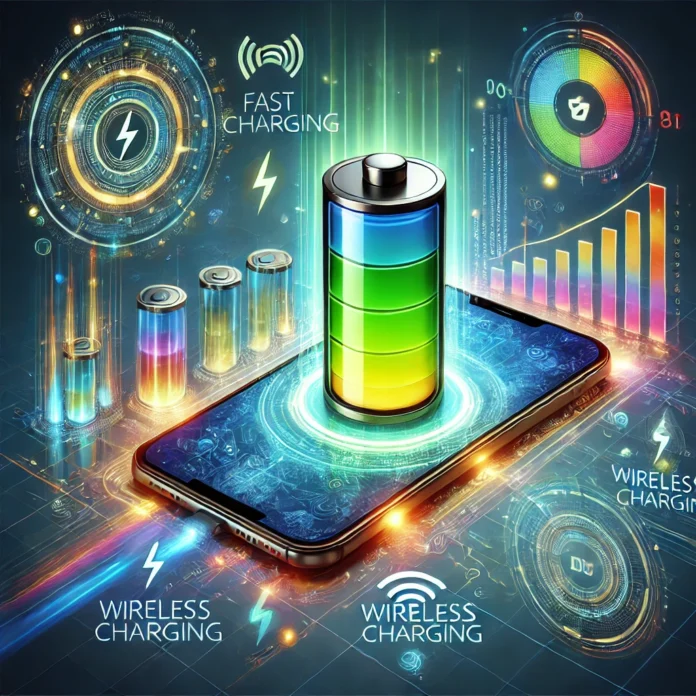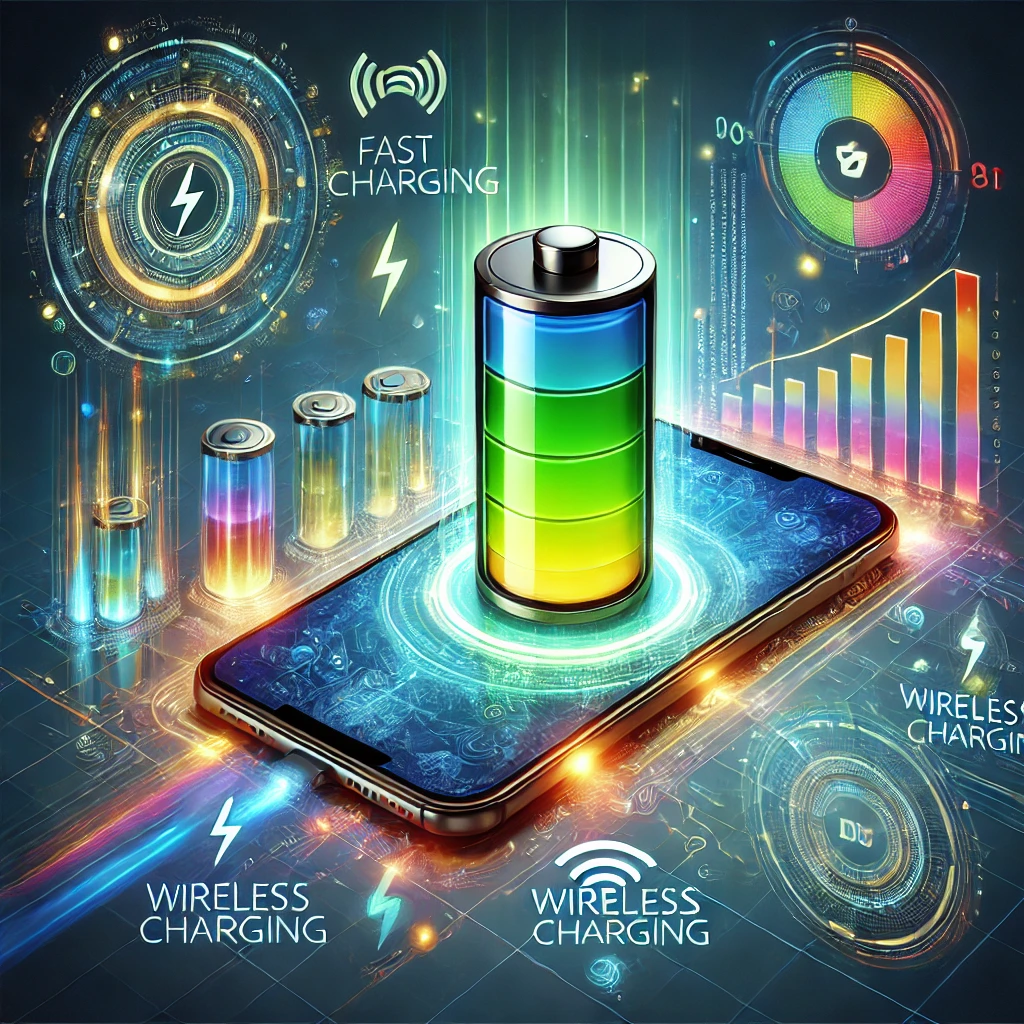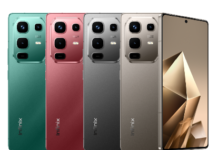
Today, smartphones are more powerful and capable than ever, functioning as essential tools for communication, entertainment, productivity, and much more. However, all these features demand significant battery life, making battery technology one of the most critical aspects of modern smartphones. As consumers seek longer-lasting devices, faster charging, and more efficient power management, smartphone manufacturers and researchers are continuously innovating to meet these demands. This article explores the latest advancements in battery technology and charging speeds, including fast charging, wireless charging, and emerging battery materials that are transforming the smartphone industry.
The Evolution of Smartphone Batteries

Since the early days of smartphones, battery technology has largely been based on lithium-ion (Li-ion) cells. Li-ion batteries became the industry standard due to their balance of energy density, durability, and rechargeability. Over the years, engineers have worked to improve this technology, but as smartphones become more powerful, demands on battery performance have increased exponentially. This has led to innovations both in battery design and in how we charge our devices.
1. Lithium-Ion Improvements
While Li-ion batteries are not new, they continue to undergo refinements to increase capacity and efficiency. Innovations such as lithium-polymer batteries, a variant of Li-ion technology, offer more flexibility in design (allowing for thinner devices) while improving battery life. Furthermore, manufacturers have focused on optimizing software to improve battery management, reducing the amount of power consumed by background apps and services.
Despite these improvements, the limitations of current lithium-ion batteries are becoming more apparent as smartphones require more power for high-resolution screens, powerful processors, and 5G connectivity.
2. Solid-State Batteries: The Future of Energy Density
One of the most promising breakthroughs in battery technology is the development of solid-state batteries. Unlike traditional Li-ion batteries, which use a liquid electrolyte to transfer energy between the anode and cathode, solid-state batteries use a solid electrolyte. This innovation offers several advantages:
Higher energy density: Solid-state batteries can store more energy in the same volume, providing longer battery life without increasing the size of the battery.
Improved safety: The absence of a liquid electrolyte reduces the risk of overheating and combustion, which has been a concern with Li-ion batteries.
Faster charging: Solid-state batteries are expected to charge more quickly than conventional batteries due to their enhanced energy transfer capabilities.
While solid-state batteries are not yet widely available in smartphones, they are being developed by major tech companies and could revolutionize battery life in the coming years.
Fast Charging Technologies
As consumers use their smartphones more heavily, the ability to quickly recharge has become a key feature. Fast charging technologies have evolved rapidly, enabling users to power up their devices in a fraction of the time it used to take.
1. Wattage and Fast Charging Speeds
Modern fast charging technologies are defined by wattage, or the amount of power that can be transferred to the battery in a given period. Higher wattage means faster charging. In recent years, we’ve seen an arms race among smartphone manufacturers to deliver the fastest charging speeds.
Qualcomm Quick Charge: This technology, which has been widely adopted in Android devices, offers fast charging through both wired and wireless options. The latest version, Quick Charge 5, can charge a phone to 50% in just five minutes, with power output reaching up to 100 watts.
OPPO SuperVOOC: Known for pioneering ultra-fast charging, OPPO’s SuperVOOC technology delivers up to 240W of power, capable of fully charging a smartphone in as little as 10 minutes.
Xiaomi HyperCharge: Xiaomi has pushed the boundaries of fast charging with its 120W HyperCharge technology, claiming that it can fully charge a 4,500 mAh battery in just 15 minutes.
These advancements in fast charging are redefining how we think about battery life. Instead of needing large batteries, users can rely on short charging sessions throughout the day.
2. Adaptive Fast Charging
As charging speeds increase, so does the risk of heat generation, which can damage the battery over time. To address this, companies have introduced adaptive fast charging, which adjusts the charging speed based on the phone’s temperature and battery health. This ensures that the phone charges quickly but without compromising the battery’s long-term lifespan. Samsung’s Adaptive Fast Charging and Apple’s Optimized Battery Charging are examples of technologies that prioritize battery health while still offering fast recharging times.
Wireless Charging: Convenience Over Cables
While fast charging is focused on speed, wireless charging offers convenience. The concept of wireless charging, which uses electromagnetic induction to transfer energy from a charging pad to the phone, has been around for several years. However, recent innovations have made wireless charging more accessible, efficient, and widely adopted.
1. Qi Wireless Charging Standard
The most common wireless charging technology today is based on the Qi standard, developed by the Wireless Power Consortium (WPC). Initially limited to low power outputs, Qi wireless charging has evolved to support up to 15 watts of charging power, reducing the time it takes to wirelessly charge a smartphone.
Apple MagSafe: Introduced with the iPhone 12, Apple’s MagSafe system uses magnets to perfectly align the phone with the wireless charging pad, ensuring maximum charging efficiency. MagSafe can deliver up to 15W of power and is also compatible with accessories such as cases and wallets.
Samsung Wireless Fast Charging: Samsung has incorporated Fast Wireless Charging 2.0 into its Galaxy line, offering up to 15W of wireless power. Samsung also supports reverse wireless charging, allowing users to charge accessories like earbuds and smartwatches by placing them on the back of their phone.
2. Reverse Wireless Charging
Reverse wireless charging is an innovation that allows smartphones to act as wireless power banks, sharing their battery life with other devices. For instance, with Samsung’s PowerShare or Huawei’s Wireless Reverse Charging, you can place wireless earbuds, smartwatches, or even another smartphone on the back of your phone to give it a charge. While this feature is still limited in terms of power output, it showcases the flexibility and convenience that wireless charging technology is bringing to the smartphone ecosystem.
3. Long-Range Wireless Charging
Looking further into the future, long-range wireless charging is an emerging technology that aims to eliminate the need for physical charging pads altogether. Companies like Energous and Xiaomi are working on solutions that can wirelessly charge devices from across the room using radio frequencies or laser beams. This technology could one day allow smartphones to charge automatically as long as they are within range of a power source, truly untethering users from cables and charging pads.
Emerging Battery Technologies
As fast and wireless charging technologies advance, research into new battery materials and designs continues to push the envelope. Several emerging technologies could further transform smartphone battery life and performance.
1. Graphene Batteries
Graphene, a material made of a single layer of carbon atoms, has the potential to significantly enhance battery performance. Graphene batteries are capable of charging much faster than traditional lithium-ion batteries, and they can hold a higher energy density, meaning they can store more power in the same space. While graphene-based batteries are still in the research phase, they hold promise for the next generation of smartphones.
2. Silicon Anode Batteries
Another promising innovation is the development of silicon anode batteries, which can store up to 10 times more energy than traditional Li-ion batteries with graphite anodes. Silicon anode batteries could extend smartphone battery life by a considerable margin, making them ideal for future devices that require more power for features like 5G, augmented reality, and AI processing.
3. Battery Health and AI Optimization
As battery technologies evolve, smartphone manufacturers are increasingly relying on AI-driven optimization to enhance battery performance. By analyzing user behavior, AI can manage power consumption more efficiently, extending the life of the battery between charges. For example, Apple’s Optimized Battery Charging feature learns from your charging habits to slow down battery aging by reducing the time your iPhone spends fully charged.












































